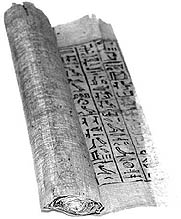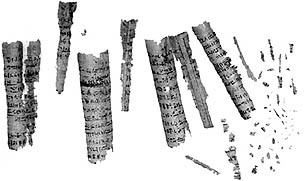Eternity on line
|
|
|
|
|
Cutting the evil serpent,
vignette from Chapter 17 of the Book of the Dead
(GD 7967 = Princeton Pharaonic roll 2, Ptolemaic
Period, 323-30 BCE)
|
Hekaemsaf's copy of the Egyptian Book of the Dead is one of 25 papyri now available online at www.princeton.edu/papyrus/, along with an online inventory of more than 800 cataloged papyri in the University Library's Department of Rare Books and Special Collections.
Swallow perching on a mummy,
vignette from Chapter 83 of the Book of the Dead
belonging to Iwt.nyr.syh (Iwtlsyh?) (Princeton
Pharaonic Roll 5, 18th Dynasty, 1570-1293 BCE)
Dating from about 1250 BCE to the 10th
century CE, Princeton's collection also includes
significant literary papryi of Homer, Aristoph-anes,
Demosthenes and other classical Greek authors; biblical
fragments and a few early Christian letters; portions of the
tax registers of the Egyptian town of Philadelphia; and
legal documents, accounting records, magical texts, school
exercises, personal letters and other documentation of
everyday life in the multi-cultural society that was ancient
Egypt. Most of the papyri are in Greek, dating from the
Roman and Byzantine periods, and were excavated in
Oxyrhynchus and the Fayum towns, though there are many in
Demotic, Coptic, Latin and Arabic.

Supported by the National Endowment for the Humanities, the online catalog project was directed by Don Skemer, curator of manuscripts. Large format color photography and scanning was done in Rare Books and in the Preservation Office, with "invaluable assistance," says Skemer, by Kirk Alexander at the Engineering School's Multimedia Engineering Computing Atelier, where the digitally enhanced images were "stitched together" electronically.
Princeton's online catalog is a component of a larger project being conducted by the Advanced Papyrological Information System, a consortium of universities that includes Berkeley, Columbia, Duke, Michigan, Princeton and Yale.
A copy of the Book of the
Dead belonging to (N)es-Ese,"a chantress of Amon"
(Princeton Pharaonic Roll 3, Ptolemaic Period,
323-30 BCE)
The Hymn to Osiris (GD 974 =
Princeton Pharaonic Roll 11, Ptolemaic Period,
323-30 BCE) is one of four hieroglyphic and
hieratic rolls that underwent conservation as part
of the NEH project. During conservation, the
papyrus was removed from its cloth wrapping and
humidified (above) to soften the fibers so that it
could be unrolled. Outer layers of papyri have
often sustained such damage that only fragments
remain (below).



top
